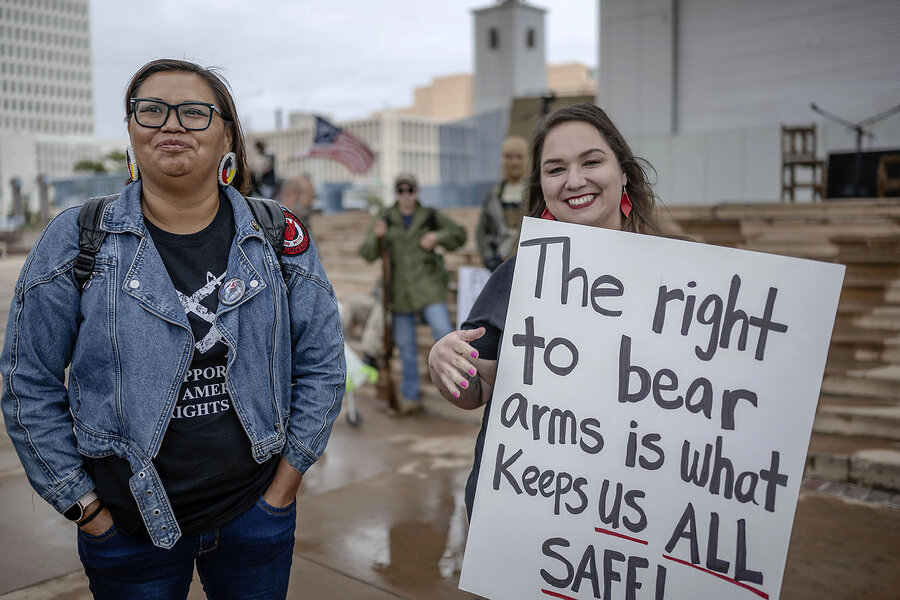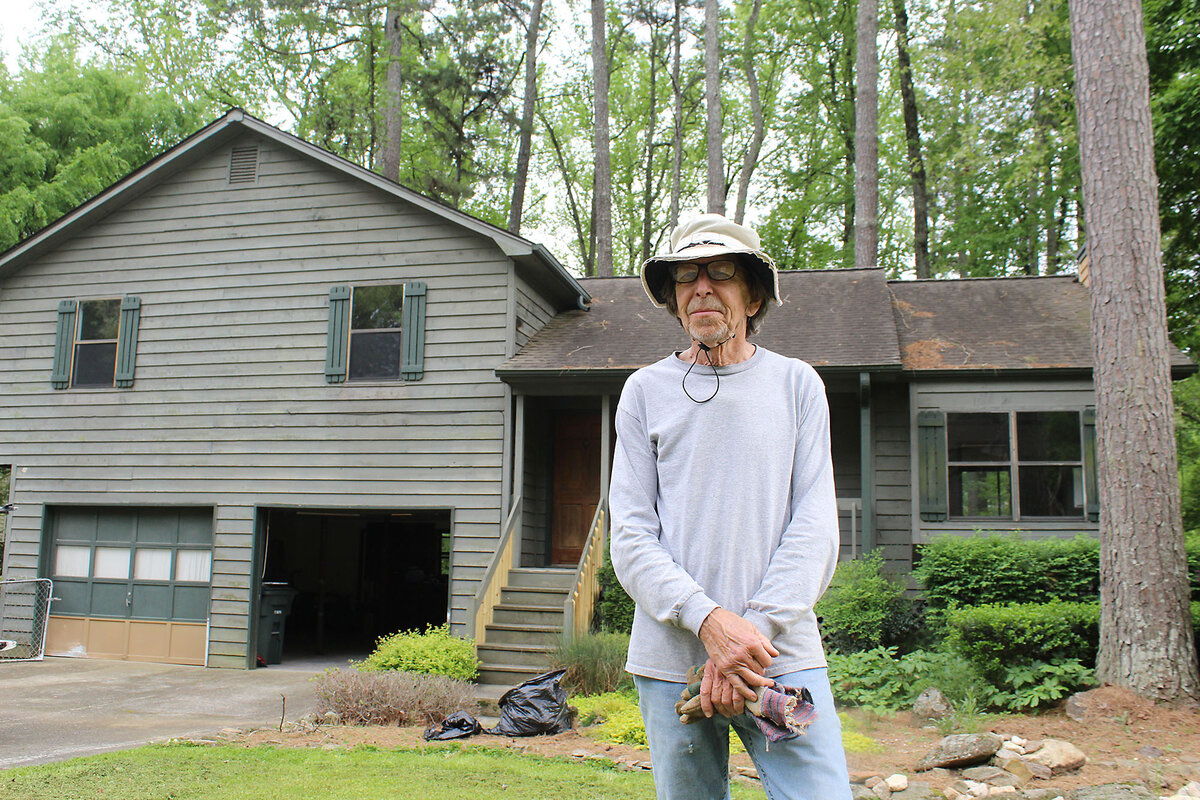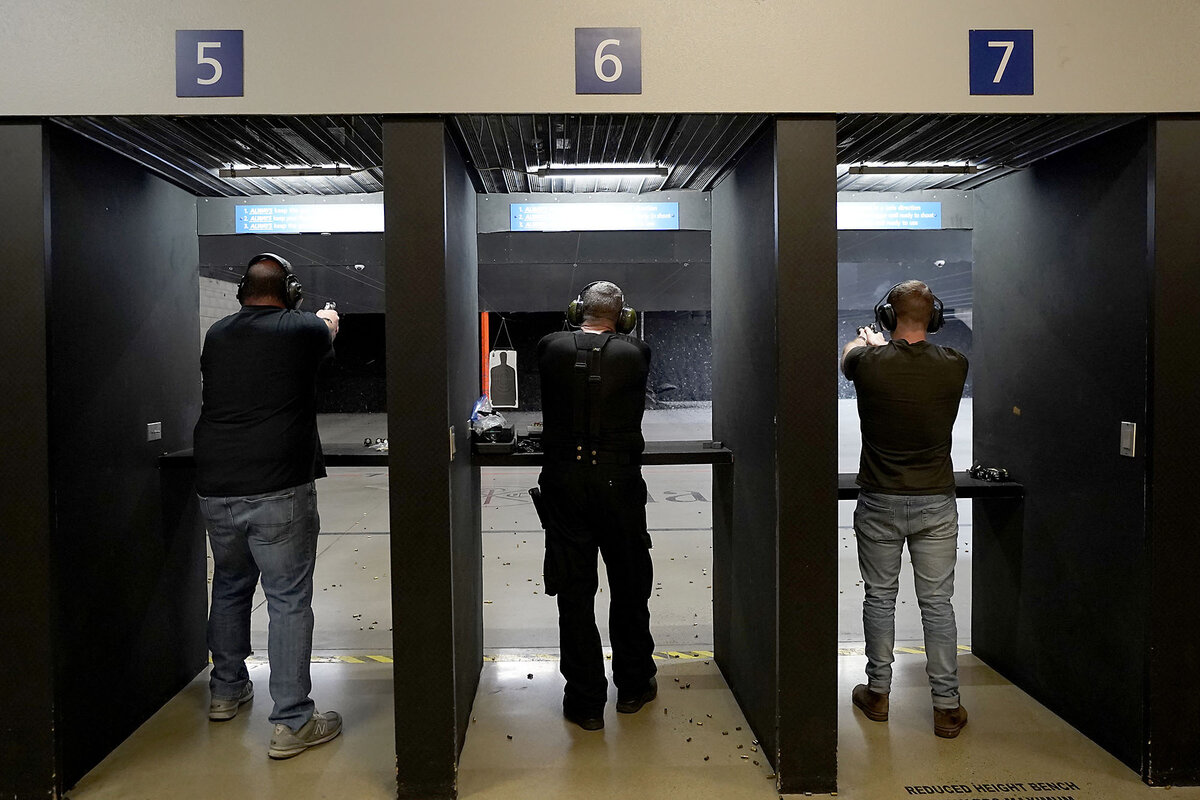On Columbine anniversary, a nation divided over guns
Loading...
| KENNESAW, Ga.
A quarter century after a tragic school shooting in Columbine, Colorado, shook the nation, America is as awash in guns as ever, and as divided over them, too.
Here in Kennesaw, Georgia, owning guns is literally a rite of citizenship.
When Johnny Downs’ wife frets about possible societal unrest and crime, he tells her, don’t worry. “I have quite the arsenal myself,” says Mr. Downs, a retiree. “I tell her, ‘OK, I’ll go dust off the bullets.’”
Why We Wrote This
A story focused onIt’s been 25 years since the Columbine High School shooting. Americans continue to square off over the interplay of guns, safety, and health – with a trust gap hindering compromise.
Kennesaw is one of only a few towns in the United States where gun ownership is mandatory for every household by law. And as Second Amendment gun rights protections have grown stronger over the past two decades, Georgia is among a growing number of states that have moved to allow permitless carry for lawful owners. Even in Hartsfield-Jackson Atlanta International Airport, the world’s busiest, travelers are in a free-to-carry zone until they enter security checkpoints.
The trends here are just one sign of a nation divided over the issue of guns.
On the one hand, some Americans increasingly view the constitutional “right to bear arms” as blanket permission to own and use guns without interference. The total number of firearms in private hands has surged in recent years, though the share of households owning guns has hovered lower in recent decades than in the 1960s, judging by Gallup polling. A rising share of owners say gun purchases are motivated by personal safety concerns, rather than by more traditional uses like hunting.
On the other hand, many Americans indicate more faith in a culture of gun regulation than in proliferation. A record 45% now say they are “very dissatisfied with the nation’s gun laws,” a peak in 24 years of Gallup polling on the issue. And U.S. adults are far more likely to want more restrictions on guns (56% as of last year) than fewer (12%).
Seeking common ground after tragedies
One reason is that gun tragedies – especially those that occur in schools like the one in Columbine 25 years ago this week that left 12 students and one teacher dead – strike hard at the national psyche. Even higher death tolls have since occurred in school shootings in Newtown, Connecticut, (2012) and Uvalde, Texas (2022).
Add in the trend of polarization over politics in general, and society’s navigation of gun issues isn’t just about trust in – or fear of – firearms. It’s also about public and private tensions over how to manage them.
“There is so much distrust, so much suspicion,” says Caroline Light, author of “Stand Your Ground: A History of America’s Love Affair with Lethal Self-Defense.”
“There are a lot of good people who are gun owners who are terrified that liberal governance is going to steal their guns,” says Dr. Light. Meanwhile “our society has aligned itself behind this belief ... that firearms are an essential tool of self-defense rather than something specifically designed for human destruction.”
Sometimes it is in the wake of tragedies when common ground is sought.
After the 2018 Parkland, Florida, high school shooting, numerous states, including Florida and others with Republican governors, passed gun safety legislation. Red flag laws have spread, barring gun access for certain individuals due to public safety risks.
After Uvalde, Congress passed the Bipartisan Safer Communities Act, boosting background checks for gun purchasers under 21 years old, and taking other steps that made it the most consequential federal gun safety legislation in nearly three decades.
And on Thursday, Maine enacted sweeping gun control reforms – including criminalizing some gun sales – six months after a mass shooting in Lewiston.
If there are glimmers of how trust gaps might be bridged, stark divides remain.
A tale of two states, and their gun laws
Few places illustrate the loggerheads over guns as well as Illinois and Georgia. Yet their similarities are as telling as their differences.
One is a Southern state with a rich firearms tradition. The other is a Midwestern one, where villages like Gurnee have long had a gun regulation mindset.
Earlier this month, concern about gun safety surfaced in Gurnee in an unusual way: Two men in ski masks and cinched hoodies walked into a popular diner holding pistols at their sides. The brunch crowd gasped.
“There was panic and concern,” says Gurnee Police Detective Shawn Gaylor. A concealed-carry permit holder started to draw his weapon to take protective action. “That’s when one of the servers realized they were water guns. They were able to stop something that could have been horrifying from happening.”
Behind the incident was an innocent-enough but perhaps tone-deaf college student game called Senior Assassins.
“We’re not saying they can’t have fun, but they need to think about what they’re doing and how it affects others in the community,” says Detective Gaylor.
Both Gurnee, Illinois, and Kennesaw, back in Georgia, have about 30,000 people. Both are major metro area suburbs. And despite different gun law climates, both have crime rates well below national averages – a reminder that public safety is about more than gun laws.
In Gurnee, Detective Gaylor’s department now holds regular training on firearm threat responses. The department also holds a “parent university” to help families with guns keep them safely locked up.
“We’re addressing the threat of somebody taking action against our community,” she says. “That’s the reality of the world that we live in now. And everybody is on heightened alert because of that.”
Debating statistics and safety laws
Still, scholars haven’t settled the question of whether a rise in the sheer number of guns – legal and illegal – means more violence. Robert VerBruggen, a fellow at the conservative Manhattan Institute, concluded in a 2022 report that the evidence for now is hard to call. Gun death rates are down since the 1990s, but higher than in the 1950s.
Gun safety laws have a clearer track record, some experts say. States with tighter regulations around gun ownership tend to have lower rates of gun deaths.
But Mr. VerBruggen says that, depending on one’s ideology, statistics can be shaped to confirm partisan talking points.
“Both sides have gotten so distrustful of each other that the policy debates are now about scoring points instead of saving lives and figuring out what’s going to work,” he says.
Those suspicions have become pervasive. “There are a lot of people walking around carrying guns to restaurants, and then there are parents who say they want to home-school their children because they are not safe at school anymore,” says Miami University historian Lindsay Shackenback Regele, author of “Flowers, Guns and Money.”
Some of the patterns have deep historical roots. Justin A. Joyce, a culture expert at Washington University in St. Louis and author of “Gunslinger Justice,” cites the influence of westward expansion and advances in gun technology as reasons behind an evolving ethos of “my property, my liberty, and all the rest be damned.”
But these days, Dr. Joyce says he is sensing “the barest seedling of a shift ... toward ... seeing [gun policy] as an issue of national health.”
Over time, research itself could become one foundation for building common ground across divides.
Jennifer Tucker, a historian and ballistics researcher at Wesleyan University, sees the health effects going beyond fatalities to include mental and psychological impacts.
“We can do better”
“I think we can do better in terms of understanding what would be needed to reduce not just fatalities and injuries, but also to understand the kinds of nonmonetary, nonbodily impacts that [gun proliferation and lethality] has on a society consumed by fear,” says Professor Tucker, founding director of the Center for the Study of Guns and Society.
For years after it was passed in 1982, the gun ownership mandate was all the buzz in Kennesaw, a town known for its Civil War history. But today, Kennesaw is a hipster enclave of Atlanta with coworking spaces near a Confederate relic shop.
Mr. Downs estimates that on his street, perhaps a third of the households have weapons. Many people have no idea that they are required. No one has ever received a citation.
Mr. Downs credits police, not the gun law, for low crime rates. As for himself, he says, “I like to live quietly and mind my own business.”
When he sits down on the sofa at the end of the day, he turns on the TV to find it almost always on his wife’s favorite station, which churns a steady stream of news.
He is more nostalgic. Most nights, the lifelong gun owner turns the channel to reruns of Mayberry, starring Andy Griffith, the “sheriff without a gun.”










